“Life has many ways of testing a person’s will, either by having nothing happen at all or by having everything happen all at once,”
Paulo Coelho wrote in his novel, The Winner Stands Alone. Coelho is talking about the all-too-human condition of facing situations that are unplanned which test our patience, resilience, and grit.
Our best-laid plans go awry – especially those for healthy behaviors, like exercising and eating well.

Enter Michelle Segar, PhD, MPH, MS, NIH-funded researcher at the University of Michigan, sustainable-behavior-change expert, and health coach.
Michelle is our go-to sage for helping us think flexibly and creatively in those stressful moments when our healthy eating and exercise plans bump up against unanticipated disruptions.
I first met Michelle when we were each advising a global digital sports company: she was engaged to provide input into the project’s behavior change methods, as she counsels companies designing coaching approaches for patient and consumer health. I was working on consumer research and strategy for the project, and we became strategic collaborators.
I appreciated and benefited from Michelle’s perspective and knowledge gleaned through many years of research into her field. The fact that she is affiliated with the University of Michigan, my alma mater, was icing on that cake.
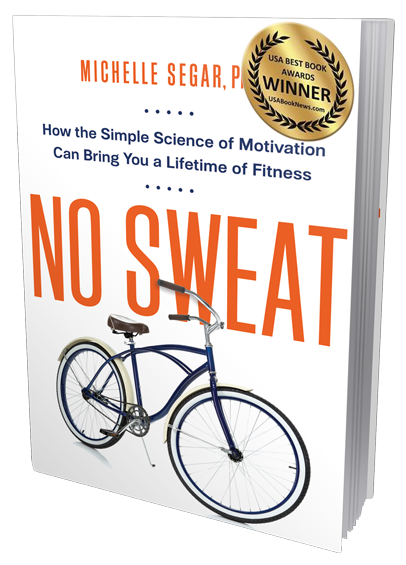 Michelle published her book, No Sweat, within a year after our collaboration. I became a beneficiary of the book’s evidence-backed advice: to opt out of a vicious cycle of failure, to replace seeing exercise as a building block that would benefit me in 20 years with viewing it as a gift to myself, an activity that would bring me energy and elevate my mood in the moment I do it.
Michelle published her book, No Sweat, within a year after our collaboration. I became a beneficiary of the book’s evidence-backed advice: to opt out of a vicious cycle of failure, to replace seeing exercise as a building block that would benefit me in 20 years with viewing it as a gift to myself, an activity that would bring me energy and elevate my mood in the moment I do it.
Seven years since the publication of No Sweat, Michelle is following up that book with The Joy Choice. I welcomed the opportunity to chat about the new work with Michelle via a Zoom meet-up last week.
We began our conversation about The Joy Choice starting with its relationship to No Sweat.
She confessed: “I didn’t think I’d ever write another book. I thought that was likely my last idea” she said, fulfilling what she thought was “the 20-year need to share” her coaching method and research findings with the world through No Sweat.
That first book received accolades and confirmation from health coaches and academic researchers alike and has been adopted across wellness, coaching, and fitness programs. Featured in The New York Times, No Sweat became the #1 book in the diet/exercise category of the USA Best Book Awards.
This first book’s primary focus was on how we could convert our relationship with exercise from something we think we should do into something we actually want to do.
“What it didn’t sufficiently address,” Michelle explained, “was what happens when we come face to face with unexpected challenges to our best-laid plans. It’s these culprits that tend to kick us right off the path of lasting change”
Think: the plans most of us make, to eating nutritiously, exercise, or schedule time to meditate.
According to Michelle, even when we transform our relationship with a healthy behavior from a chore into a gift, “stuff” will always happen, and when those challenges occur, all-or-nothing thinking is our go to .
“In my work as a coach, I’ve found all-or-nothing thinking to be extremely common and also among the most challenging mindsets for clients change,” Michelle told me.
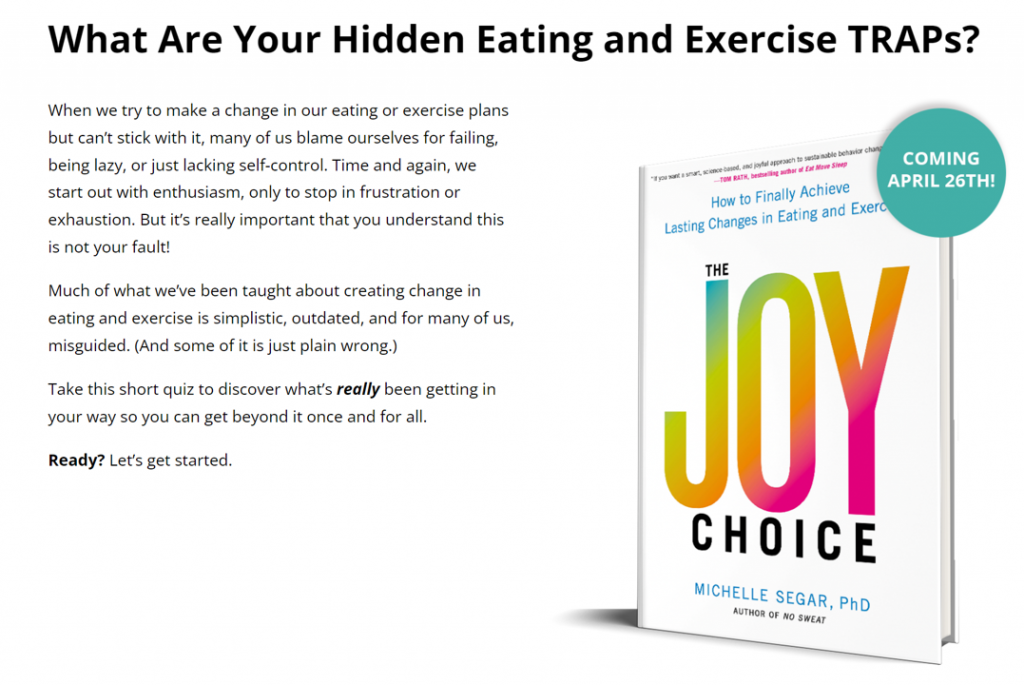
She said that simply suggesting clients stop their “all or nothing” thinking doesn’t work because it reflects a deeply embedded belief system that we’ve been socialized to have about what the “right” exercise and healthy eating looks like. “All-or-nothing thinking traps creative problem solving in the face of conflicts because the only alternative within this binary is the nothing,” Michelle said.
That kind of thinking is akin to this: “my son is not eating the broccoli we made for dinner, so we are not going to feed him anymore,” Michelle analogized. Or, “our friend can’t meet us for coffee at the café in an hour, as we had planned, so we dump her.”
“When we look at all-or-nothing thinking outside of the realms of exercise and healthy eating, in our other life arenas” Michelle told me, “its ineffectiveness and harmfulness becomes obvious.”
Part of the reason we think in all-or-nothing ways at these moments of conflicts is because when we initially create our plans it is in what Michelle calls an idealized “motivation bubble.”
The graphic below displays the logic behind how this plays out.
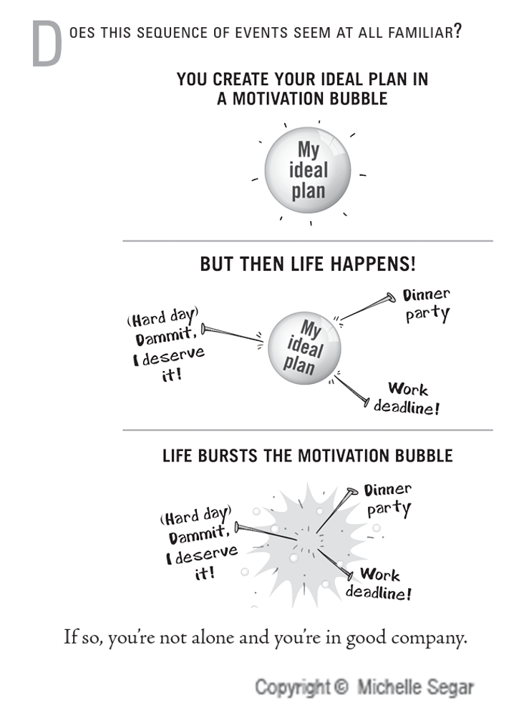 She emphasizes that instead of the counting on the ideal with our healthy eating and exercise plans, we would benefit from assuming the unexpected, and be ready to pivot when unanticipated needs challenge our plans. In her words from the book,
She emphasizes that instead of the counting on the ideal with our healthy eating and exercise plans, we would benefit from assuming the unexpected, and be ready to pivot when unanticipated needs challenge our plans. In her words from the book,
“Change happens in each moment, with the choices and compromises we make when faced with the challenges of daily life: An urgent call cut into your planned exercise class! Should you work out for a shorter time than you’d planned? Replace the class with five minutes of dancing with your kids? Drop the whole idea of exercise today? We can’t stop these unexpected conflicts form arising, but we can learn how to stop them from derailing our greater goals.”
Michelle wrote The Joy Choice to share what emerging science about the brain and decision making (and established practices in learning) suggests about how to better help people stick with their greater lifestyle goals when their daily plans confront an unexpected conflict.
“The new strategy isn’t sexy, but it is common sense: it’s helping people learn to value doing something instead of nothing.” A new decision strategy that Michelle branded the Joy Choice.
She backs her contentions about the Joy Choice up by describing studies showing that choosing an imperfect alternative at an eating or exercise challenge better predicts long-term behavior than the more common strategy of “trying to stick to the plan perfectly.”
I asked Michelle for a real-life example of one of her clients who used the Joy Choice to deal with a disrupted healthy behavior plan.
She told me about a woman who was a committed Peloton user. One day, she jammed her knee going down the stairs, and immediately thought to herself – “Darn it, I can’t do Peloton today because I have to give my knee a break.”
But she remembered what she had recently learned from Michelle and thought, “wait a second… there must be alternatives to doing Peloton today, I can make the Joy choice!”
She realized that walking would be much gentler on her knee, called up a friend, and deemed this friendly stroll a ‘Joy Choice,’ the perfect imperfect alternative to that exercise snafu.
Michelle told me that the Joy Choice invites us to step out of our automatic tendency toward all-or-nothing thinking when “stuff” happens – and engages and supports our executive functions (the innate mental abilities we use to make decisions, manage long-term projects, and solve problems) through:
- Simplifying the mental calculus we need to do at points of conflict with our plans through her 3-step decision tool POP;
- Playing with the possibilities and alternatives to our original plan; and
- Choosing Joy, the perfect imperfect option that keeps us moving forward on the path of lasting change and self-care.
“The Joy Choice strategy empowers us to take charge of the situation and enter into a new decision-making process with curiosity and creativity. This takes us out of discouragement, narrowed thinking, and negative self-talk and inspires us to open up to the options beyond our original set plan,” Michelle summarized.
Health Populi’s Hot Points: Michelle reminded me that April is Stress Awareness Month.
We are stressed out, the American Psychological Association discussed in a March 2022 research paper based on a survey among U.S. consumers fielded March 1-3. More people rated inflation and issues related to the Ukraine invasion as stressors than any other issue APA has studied in the 15-year history of their Stress in AmericaTM poll.
In living life during the COVID-19 pandemic, Michelle has found that her clients and organizations resonate even more with the Joy Choice concept. “Before COVID-19 everyone knew that self-care was important for our mental, emotional, physical, and spiritual needs and to generate the energetic resources we need to tend to the people and projects that we dearly care about. But it was too easy for other priorities to take over. But from the emotional toll and stress from COVID it’s become clear just how essential self-care really is”
And because the boundaries between our many roles and responsibilities got so blurred, we learned that all-or-nothing approaches for exercise and healthy eating and other self-care activities have trouble surviving in our complex day. Aiming for perfection often leads to nothing at all.”
“On individual, organization, and societal levels we need to cultivate a more flexible mindset to self-care activities like healthier eating and exercise. Once we start to lean into this new belief system and approach the options are unlimited,” Michelle argues.
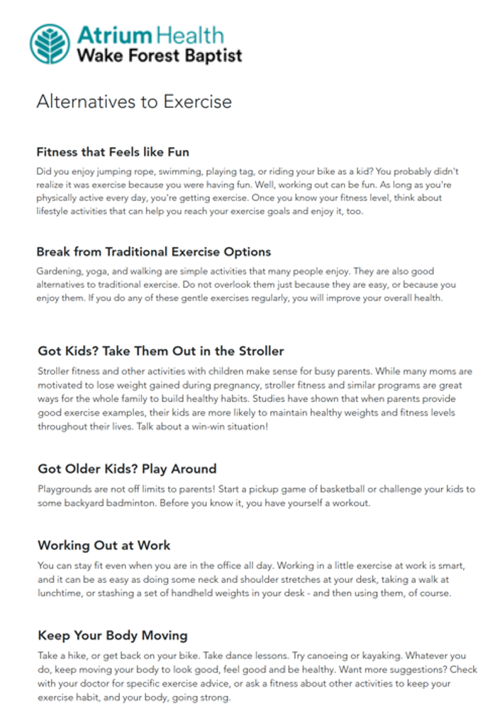 This list of “alternative exercise” options offered by Atrium Health below offers a useful roster of examples we can opt into when life derails our original plan for riding the Peloton bike, taking a 4-mile run, or going to the gym. These joyful ideas include jumping rope, riding a bike, swimming, gardening, playing at the playground, and taking part in a pick-up basketball game at the corner court.
This list of “alternative exercise” options offered by Atrium Health below offers a useful roster of examples we can opt into when life derails our original plan for riding the Peloton bike, taking a 4-mile run, or going to the gym. These joyful ideas include jumping rope, riding a bike, swimming, gardening, playing at the playground, and taking part in a pick-up basketball game at the corner court.
If you pre-order the book before April 26, you will be invited to participate in an exclusive, live four-session book club personally hosted by Michelle. You will receive a special workbook for The Joy Choice as well. Check out this link to take part in this opportunity.
You can also follow the book’s Twitter discussion and feed at #TheJoyChoice.


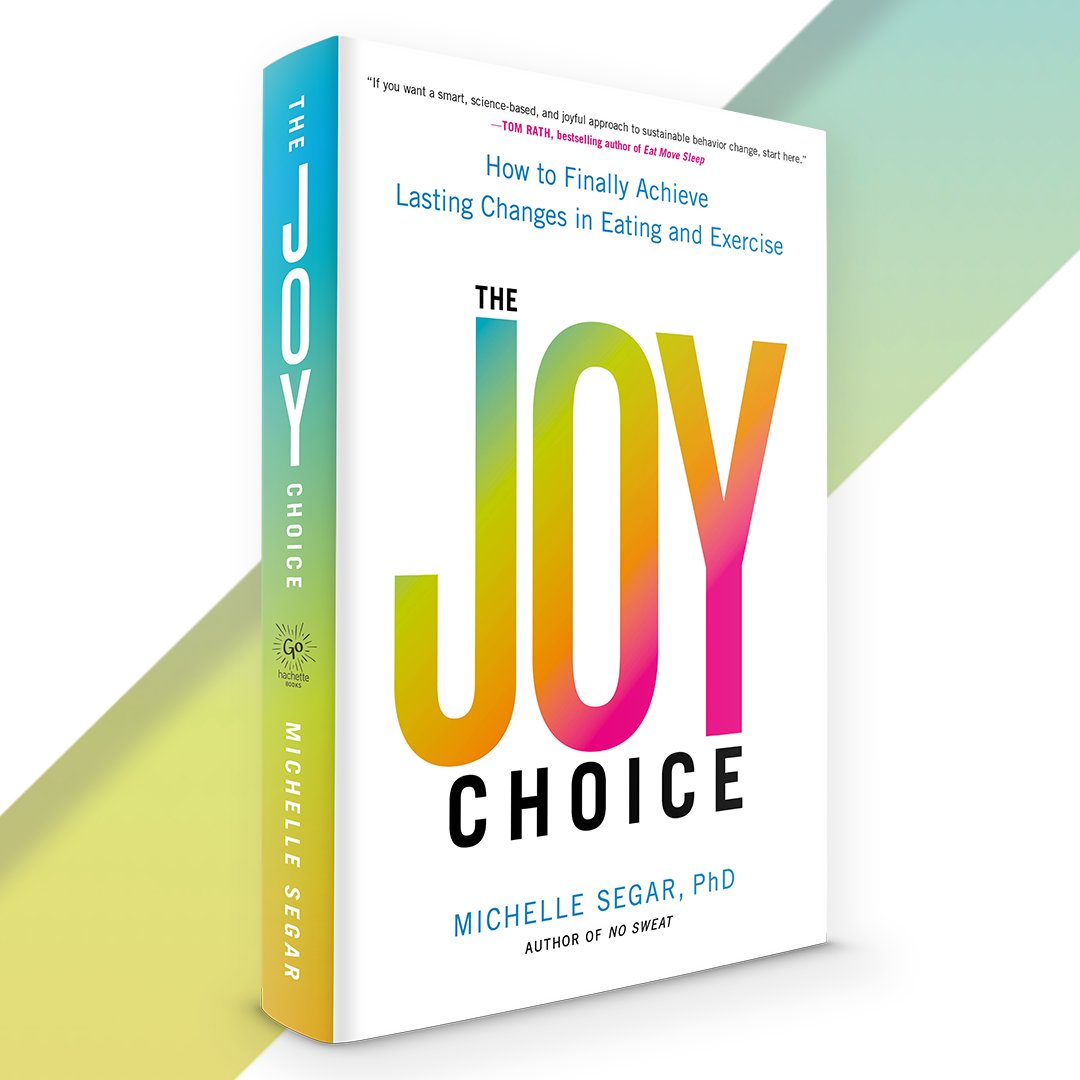


 Thanks to Feedspot for naming this blog, Health Populi, as a
Thanks to Feedspot for naming this blog, Health Populi, as a